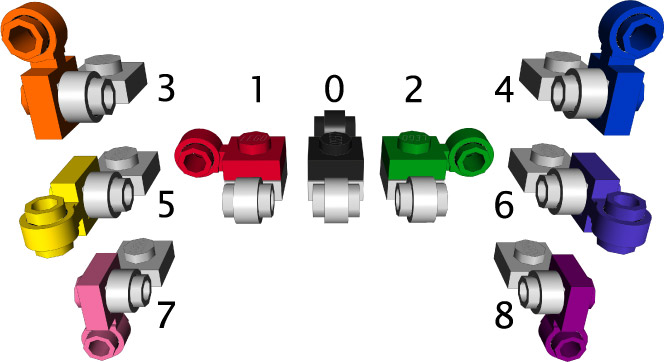Anyone who tinkers much with Lego soon develops an affection for element 4081—the so-called “clip light.” 1 It consists of a 1×1 square plate with a vertical, circular “clip” attached to one side. This “clip” is unique, to my knowledge, among Lego elements, in that it consists, essentially, of a plate with studs on both sides.
I am interested in the many ways that long “polymers” of clip lights can be strung together, and the shapes that result. The metaphor to polymer chemistry is very useful, and I will be using its terms pretty freely. The “monomer,” then, in all cases, is a single clip light element. And to understand the properties of the polymers, we need to first consider the set of possible “dimers”—that is, all the ways that one clip light can “bond” to another.
There are nine of them, that I have identified, and I have numbered them 0-8 and color-coded them according to the diagram above. To identify a particular bond, we first rotate the parent monomer into “standard position,” indicated above by the recurring gray monomer, which is, as presented, with the stud on top and the edge bearing the clip rotated toward the viewer. The nine orientations in which a child monomer can bond to the parent are then enumerated. The color of any monomer is determined by its relationship to its parent monomer. The starting monomer, which has no parent, is always colored gray.
Even numbers are given “cool” colors and correspond to “right-handed” bonds, while the corresponding “left-handed” bonds are given odd numbers and “warm” colors. Black, a neutral color, is reserved for the only non-enantiogenic bond relationship, the plate-to-plate back-to-back bond, and is numbered 0.
Notes:
- In point of fact, there are two elements 4081: 4081A, the so-called “Type 1” clip light, has a thinner ring and is much less common than 4081B, the “Type 2” clip light. Including Type 1 clip lights may have interesting structural consequences, which I may want to explore later. But for now, I’ve limited myself to polymers consisting solely of elements 4081B. ↩

